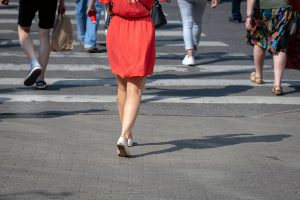Taking A Walk Should Be Good For Your Health
 Michael Babboni
Personal Injury
When the New Year rolls around, many people resolve to make good health their main priority. This can involve eating better and getting more exercise. Taking a brisk walk on a regular basis will not only help you meet part of your goal, it will also help you:
Michael Babboni
Personal Injury
When the New Year rolls around, many people resolve to make good health their main priority. This can involve eating better and getting more exercise. Taking a brisk walk on a regular basis will not only help you meet part of your goal, it will also help you:• Maintain a healthy weight
• Prevent chronic conditions such as heart disease, type 2 diabetes, and high blood pressure
• Strengthen your bones and muscles
• Improve your balance and coordination
• Reduce depression and anxiety
Walking outside is a great way to add a healthy dose of fresh air to your walk, and it’s a great way to enjoy the Florida sunshine. Unfortunately, many pedestrians who are innocently enjoying their daily dose of exercise are hit and injured by drivers in the U.S. every year.
Know The Rules To Avoid Becoming A Statistic
Between 2005 and 2014, there were 46,149 pedestrians killed by cars in Florida; 4,884 of them were killed in 2014 alone. Nine out of the 20 most dangerous metropolitan areas for pedestrians in 2016 were in the state of Florida. While no one wants to think about, or become, one of these statistics, knowing how commonly it occurs can help you stay diligent whenever you embark on a walking journey.
Pedestrians must stay on the sidewalk and out of the roadway at all times. When a sidewalk is not available, pedestrians should walk on the shoulder of the left side of the road facing traffic. They are subject to the laws of traffic devices unless otherwise directed by a police officer. When crossing the roadway, pedestrians must follow these rules:
• Do not leave the curb until directed to do so by the traffic signal.
• Keep to the right half of a crosswalk.
• Cross the road only at a right angle or the shortest route (when not in a crosswalk).
• Do not cross between adjacent intersections unless in a marked crosswalk.
• Common Reasons For Pedestrian Accidents
• Some of the most common reasons for pedestrian accidents include:
• Driving under the influence of drugs or alcohol
• Distracted driving – using electronics
• Dangerous road conditions
• Reckless driving
• Malfunctioning crosswalk signs or traffic signals
• Drivers who neglect traffic laws and traffic control devices
• Insufficient signs around construction areas
Many of these issues are the fault of the driver, but some can be the fault of the municipality. When a traffic signal malfunctions and the result is a pedestrian accident, the injured party can seek compensation from the city or town.
Knowing who is at fault in the accident can help you determine who should be held responsible for the injuries you suffered. Florida is a comparative negligence state, which means that even if the pedestrian is partially at fault in the loss, they can still recover a percentage of their damages.
What To Do If It Happens To You
If you are conscious after being hit by a vehicle, you might still be in shock. Do your best to take the following steps to ensure protection of your legal rights and your future.
• Call 911 for immediate medical assistance and a full medical evaluation – even if you think you feel “fine.”
• Take a personal inventory of yourself. Look for visual injuries, blood, or torn clothing. Make a note of all of your injuries and report them to the paramedics upon arrival.
• Contact the police. It’s important to tell the officer exactly what you remember as soon as possible.
• Take pictures of the scene, the vehicle that hit you, and your injuries. Speak with people who witnessed the occurrence.
• Don’t discuss fault at the scene of the accident, or with the driver’s insurance company. Do not sign any documents or accept any monetary settlements.
• Contact your own auto insurance company to make them aware of the accident. Most policies have coverage for a pedestrian accident.
• Seek legal advice from a qualified attorney in St. Petersburg. This will help decide if it’s a case you want to pursue. You’ve already suffered enough trauma in the accident; a good attorney will help make the legal process that follows as painless as possible.
